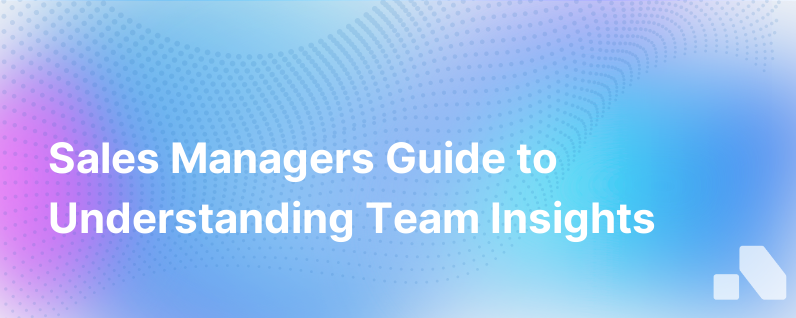
"Dammit Jim, I'm a Sales Manager, Not a Mind Reader!" The Essential Guide to Understanding Customer Needs
Clichéd as it may seem, being a sales manager does often feel like you're expected to read minds — to preemptively understand customer needs, dissect their unspoken objections, and forecast market trends with unequivocal accuracy. In the world of B2B sales, gathering customer insights is not driven by telepathy but by an insightful understanding of human behavior, adept use of technology, and effective communication skills.
So, let's beam into the nucleus of this enigmatic conundrum, deciphering how sales managers can effectively operate as strategic empaths — those who expertly navigate customer psychology and market dynamics to secure wins without possessing extrasensory abilities.
The Foundations of Understanding
Going Beyond Surface Interactions
To preempt customer needs, it’s essential to dive deeper than surface-level interactions. The goal is to understand the problems your customers are trying to solve and, more importantly, the underlying motivations for their behavior. This requires asking probing questions and adopting a consultative mindset rather than a transactional one.
Active Listening and Observation
Often, what customers say and what they actually need are not perfectly aligned. Active listening — paying attention not just to the words being spoken but also the tone, pace, and pauses in conversation — can reveal the nuanced truths that lurk beneath the surface. Observation of their business operations can further pull back the curtain, exposing the realities of their daily challenges.
Data-Driven Insights
Mind-reading skills are merely a fanciful wish when compared to the predictive potency of data analysis. By employing CRM tools that track customer interactions, purchase history, and sentiment, sales managers can spot trends and anticipate needs before they manifest into explicit demands.
The Force Multipliers
Leveraging Technology Empathetically
In an era where AI can provide insights akin to clairvoyance, leveraging platforms that synthesize and interpret data gives sales managers an almost otherworldly edge. Solutions like Salesforce and HubSpot enable sales teams to personalize their approach at scale, predicting customer needs based on historical data and engagement patterns. For a more tailored offering, Aomni delivers real-time account research and competitive intelligence, essentially serving as the digital crystal ball of sales.
Training for Empathy
Understanding customer needs is as much a skill as it is an art. Regular training focusing on emotional intelligence, empathy, and effective questioning should be a staple in every sales manager's development playbook. Role-playing exercises, workshops, and even improvisational theatre techniques can enhance a team’s ability to read between the lines and sense unvoiced customer sentiments.
The Human Touch in a Digital World
Technology cannot and should not replace the human element of sales. Even as digital tools provide insights, it is the sales manager's role to humanize that data, translating it into relatable solutions that resonate with customers on a personal level. Your ability to relate and tell a compelling story is your bridge over the telepathic gap.
Implementing the Wizardry of Insightful Salesmanship
Continuous Customer Engagement
Regularly engaging with customers throughout their journey fortifies trust and keeps communication channels open. Through consistent touches — such as follow-up emails, educational webinars, or casual check-in calls — sales managers remain tapped into the evolving needs of their clientele.
Creating Feedback Loops
Constructive feedback loops can convert customer interactions into goldmines of information. After closing a deal, reach out to understand what factors led to the customer's decision. This feedback not only reinforces their choice but also provides invaluable insights for refining future approaches.
Account Planning Precision
Comprehensive account planning that includes projections of customer needs and growth opportunities can replace guessing games with strategic foresight. This involves an intricate understanding of the customer’s business model, market position, competition, and industry trends to anticipate where your product or service can deliver added value.
Tailored Value Propositions
The ability to craft tailored value propositions requires a deep understanding of your customer’s unique position and ambitions. By aligning your offering to their strategic objectives and communicating it in a way that strikes a chord, you become the maestro orchestrating a symphony of solutions catering to your customer's unsaid needs.
Collaboration and Cross-Pollination
Sales is not an isolated function but intersecting with marketing, product development, and customer service. Cross-departmental collaboration allows for a richer understanding of customer narratives and more resourceful problem-solving.
Conclusion
To be a sales manager is to be a problem-solver, an analyst, a relationship builder, and, above all, an empathetic listener. Improved customer understanding does not necessitate clairvoyance but rather a strategic combination of empathy, data, and technology.
While we may not be mind readers, we are orchestrators of information. With continual learning, leveraging the right tools, and maintaining a focus on enhancing customer relationships, sales managers can predict and meet customer needs with impressive precision — no telepathy required. In the ever-evolving landscape of B2B sales, platforms like Aomni hone these capabilities, transforming complex data into clear, actionable insights.
By adopting such tools and strategies, you stand ready to respond to your customer's evolving needs, armed not with an all-seeing eye, but with a combination of keen observation, empathetic engagement, and insightful analysis. Dammit Jim, you may not be a mind reader, but with the right approach, you'll be remarkably close.